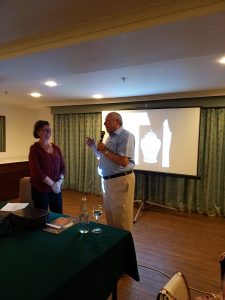On Wednesday 16th of October Joan Barnewell from Dublin, Ireland delivered a very well-received talk on The Story of Chinese Porcelain and its Journey to the West. Joan’s talk was inspired by her interest in the arts of Imperial China and in particular her love of the Qing Dynasty porcelain in the Chester Beatty collection where Joan has been a tour guide for many years.
After a brief history of Chinese pottery and porcelain, Joan introduced us to the famous kilns in Jingdezhen. We learned of the remarkable people who climbed the mountain every day for the secret ingredient-kaolin-and carry it down the mountain where it was processed and fired in enormous kilns to make beautiful objects for the Imperial Palace-and eventually for Europe.
We followed the boatmen and stick-men on their arduous 700-mile journey. They carried the precious porcelain across large lakes, through rivers, across rapids and rough slippery terrain and through steep mountain passes in all weather to reach the port of Canton. The labourers were met there by the merchants and were photographed by the renowned Scottish photographer John Thomson.
It was here in the 16th century that the Dutch and Portuguese ships carrying porcelain
began their journeys reaching Europe several months later-if they were lucky. Many ships did not make it. The shipwrecks which would have been a disaster at the time have proved to be a blessing as porcelain…. like gold is not affected by being under the sea.
In 1604 a consignment of 100,000 pieces of porcelain reached Holland on the SS Catania and was sold at auction it caused a stir. Everyone who could afford it wanted it.
If the secret of how it was made could be found…. there was a fortune to be made.
A French Jesuit missionary priest managed to get the details from some of his Catholic converts and the rest is history.
Today the Chinese are buying back porcelain at auctions around the world. We saw a slide of a sixteen-inch vase from the 18th century which had been used as an umbrella stand. It sold to a buyer from Beijing for $43 million.
After 2000 years porcelain is still being made in Jingdezhen a testament of Chinese adaptability, great artistry and craftsmanship and the beauty of porcelain.
Many thanks to Joan for giving us an extremely interesting talk increasing our knowledge and appreciation of fine porcelain from past to present.




